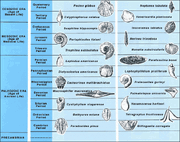No edit summary |
|||
| Line 1: | Line 1: | ||
| − | [[File:Age, Rocks, and Index Fossils.mp4|thumb|right| |
+ | [[File:Age, Rocks, and Index Fossils.mp4|thumb|right|335px|This video discusses the importance of geology in regards to the topic of evolution. The discussion of index fossils begins at 8:53. Source: Arthur, 2013]] [[File:Index_fossils.gif|thumb|A key to index fossils and their corresponding geologic time scale. Source: U,S. Geological Survey, 1997]] |
Index fossils are fossils that were fairly common and found in a number of regions, however, they were only present for a short period of time (Ghosh, 2006. Because of their abundance and short life span, these fossils can be used to determine relative and absolute age of rock layers. Index fossils are useful in helping determine rock layers in different areas based on similar index fossil discoveries. Relative age of rock layers refers to the age of one rock layer relative, or compared to, another (U.S. Geologic Survey, 2001). A rock layer containing a Pecten gibbus is younger than a rock layer containing Trophites subbullatus (see image). The discovery of an index fossil near another unknown fossil could be used to date the unknown fossil (Ghosh, 2006) . |
Index fossils are fossils that were fairly common and found in a number of regions, however, they were only present for a short period of time (Ghosh, 2006. Because of their abundance and short life span, these fossils can be used to determine relative and absolute age of rock layers. Index fossils are useful in helping determine rock layers in different areas based on similar index fossil discoveries. Relative age of rock layers refers to the age of one rock layer relative, or compared to, another (U.S. Geologic Survey, 2001). A rock layer containing a Pecten gibbus is younger than a rock layer containing Trophites subbullatus (see image). The discovery of an index fossil near another unknown fossil could be used to date the unknown fossil (Ghosh, 2006) . |
||
Revision as of 20:08, 6 December 2013

Age, Rocks, and Index Fossils.mp4
This video discusses the importance of geology in regards to the topic of evolution. The discussion of index fossils begins at 8:53. Source: Arthur, 2013

A key to index fossils and their corresponding geologic time scale. Source: U,S. Geological Survey, 1997
Index fossils are fossils that were fairly common and found in a number of regions, however, they were only present for a short period of time (Ghosh, 2006. Because of their abundance and short life span, these fossils can be used to determine relative and absolute age of rock layers. Index fossils are useful in helping determine rock layers in different areas based on similar index fossil discoveries. Relative age of rock layers refers to the age of one rock layer relative, or compared to, another (U.S. Geologic Survey, 2001). A rock layer containing a Pecten gibbus is younger than a rock layer containing Trophites subbullatus (see image). The discovery of an index fossil near another unknown fossil could be used to date the unknown fossil (Ghosh, 2006) .
Discovery
Index fossils were discovered by an English civil engineer by the name of William "Strata" Smith (U.S. Geologic Survey, 2001). He published Strata Identified by Organized Fossils explaining his findings (William Smith (geologist), n.d.). By collecting and iinventorying fossils, Smith was able to reconstruct the geologic time of England and became known as "Father of English Geology" (William Smith (geologist), n.d.).
Resources
Arthur, M. (2013, January 6). Age, Rocks, and Index Fossils.mp4. [Video File]. Retrieved from http://www.youtube.com/watch?v=ydDuT5V9zwM
Ghosh, D. (2006). Index fossils. Resonance, 11(10), 69-77. Retrieved from http://111.93.135.171/ResonanceNew/Volumes/11/10/0069-0077.pdf
U,S. Geological Survey, (1997, July 28). Index Fossils. Retrieved from http://pubs.usgs.gov/gip/geotime/fossils.html
U.S. Geological Survey. (2001, June 13). Relative Time Scale, Retrieved from http://pubs.usgs.gov/gip/geotime/relative.html
William Smith (geologist). (n.d.) In Wikipedia. Retrieved Novermber 30, 2013 from http://en.wikipedia.org/wiki/William_Smith_(geologist)